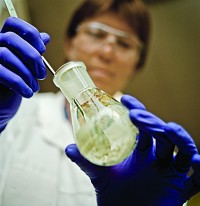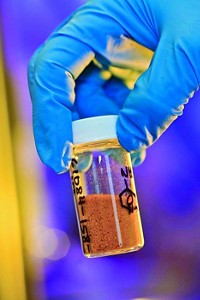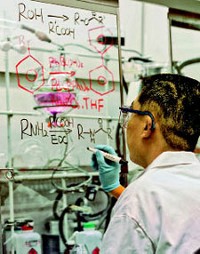Advertisement
Grab your lab coat. Let's get started
Welcome!
Welcome!
Create an account below to get 6 C&EN articles per month, receive newsletters and more - all free.
It seems this is your first time logging in online. Please enter the following information to continue.
As an ACS member you automatically get access to this site. All we need is few more details to create your reading experience.
Not you? Sign in with a different account.
Not you? Sign in with a different account.
ERROR 1
ERROR 1
ERROR 2
ERROR 2
ERROR 2
ERROR 2
ERROR 2
Password and Confirm password must match.
If you have an ACS member number, please enter it here so we can link this account to your membership. (optional)
ERROR 2
ACS values your privacy. By submitting your information, you are gaining access to C&EN and subscribing to our weekly newsletter. We use the information you provide to make your reading experience better, and we will never sell your data to third party members.
Business
Strong Profit Gains For Big Drug Producers
First-quarter results signal that cost-cutting measures are helping the bottom line
by Lisa M. Jarvis
May 22, 2006
| A version of this story appeared in
Volume 84, Issue 21
Though u.s. pharmaceutical companies clearly have not been operating at their peak over the past several years, the cost-cutting initiatives implemented across the industry in 2005 are starting to help the bottom line. Good first-quarter results could be an early sign of a return to stronger sales and profit growth in 2006.
The average first-quarter profit margin for the 13 large drug companies tracked by C&EN was 26.8%, a considerable improvement over the 23.2% margin reported in the first quarter of 2005. Earnings soared 19.9% over the same period in 2005, based on a 3.6% rise in sales.
European companies propped up the overall results, reporting combined earnings growth of 34.3% and an 8.5% increase in sales, but the major U.S. firms are starting to recover after several years that did not meet analysts' expectations. Though profit margin growth for the U.S. companies had stalled in 2005, the industry appears to have shifted back into gear. Average U.S. profit margins rose to 25.0% in the first quarter, compared with 22.7% during the first quarter of 2005.
The improvement can be attributed in large part to companies' efforts to rightsize their businesses. "At this time, all companies are either engaged in restructuring activities or are planning them," says Deutsche Bank stock analyst Barbara Ryan in a note to clients. Merck and Pfizer both unleashed sweeping, multi-billion-dollar cost-cutting initiatives last year aimed at streamlining manufacturing and improving R&D, while Bristol-Myers Squibb (BMS), Wyeth, and Schering-Plough have all launched smaller scale programs.
"This is a necessary endeavor and obviously a positive," given that the pharma majors were able to beat analysts' expectations by lowering their expenses, Ryan says.
At the same time, industry observers are encouraged by a spate of important drug approvals handed down from the Food & Drug Administration in the first quarter. Pfizer received approval for its inhaled-insulin product Exubera, the cancer drug Sutent, and the antifungal Eraxis, which Pfizer gained through its acquisition of Vicuron; Merck got a nod for its vaccine Rotateq and has two more vaccines under FDA review; and BMS launched its arthritis drug Orencia, which was approved in late 2005.
And last, U.S. drug firms are seeing a short-term boost in sales volume from the Medicare prescription drug plan, for which coverage kicked in on Jan. 1, says Morgan Stanley analyst Jami Rubin.
Analysts were particularly impressed with Merck's first-quarter performance, a sign that its aggressive moves to revitalize its business are working. Earnings were up 24.7% to $1.7 billion, based on virtually flat sales of $5.4 billion.
Though sales of the firm's cholesterol drug Zocor were down 4% to $1.1 billion due to generics competition in several markets, the drug saw a 13% increase in sales in the U.S. Rubin believes Zocor is benefiting from renewed growth in the cholesterol drug class following the implementation of Medicare prescription coverage, but she cautions that the sales hike will be short-lived, because the drug loses patent protection in the U.S. in June.
The highlight for Merck remains its cholesterol joint venture with Schering-Plough. The monotherapy cholesterol drug Zetia brought in $415 million, a 25% increase, while sales of the combination therapy Vytorin more than doubled to $378 million.
Schering-Plough also continued on the road to recovery in the first quarter, posting the strongest sales growth from among the U.S. companies. Earnings nearly tripled to $372 million, based on a 7.7% improvement in sales to $2.6 billion.
The company benefited from the strength of the cholesterol joint venture with Merck, along with the stabilization of its allergy and hepatitis franchises. Nasonex sales were up 25% to $229 million, and sales of Clarinex improved 11% to $160 million. Sales of Peg-Intron increased 16% to $196 million, and Rebetol sales were up 22% to $78 million.
Behemoth Pfizer continued to be one of the weakest performers of the group, hit by the combined effect of patent losses on several key drugs throughout 2004 and 2005 and the withdrawal of the COX-2 inhibitor Bextra in the first quarter of last year. Though first-quarter profit improved by 11.5% to $4.5 billion, sales slid by 3.3% to $12.7 billion.
Competition continues to challenge Pfizer's top-selling cholesterol drug Lipitor. The modest 3% increase in quarterly sales of Lipitor to $3.1 billion could make it difficult for Pfizer to meet its $13 billion sales goal for the drug for the full year.
However, several of the firm's newer products are experiencing robust growth. The pain treatment Lyrica is pushing toward blockbuster status, with first-quarter sales growing to $192 million, versus $20 million in the first quarter of 2005. Sales of the antipsychosis drug Geodon were up 32% to $182 million. Meanwhile, the COX-2 drug Celebrex is making a comeback, with sales reaching $491 million in the quarter, a 19% increase.
The heavyweight of the European companies also offered the weakest results. Earnings at GlaxoSmithKline were up 24.4%, but sales grew by just 2.9% in the quarter. Sales in GSK's HIV franchise grew a meager 4% to $694 million. Generic versions of the allergy drug Flonase, launched with just three weeks left in the quarter, quickly cannibalized market share of the branded product and pushed sales down 27% to $228 million.
However, GSK managed to balance the impact of competition in its key franchises with strength in its vaccines business, which saw a 44% surge in sales to $637 million.
Sanofi-Aventis and Novartis, which each approach GSK in size, fared better. First-quarter earnings at Sanofi-Aventis jumped 53.5%, while sales increased 9.6% to $8.5 billion.
Novartis was lifted by the strong performance of its generics unit, Sandoz. Overall earnings jumped 32.4% to $2.0 billion, based on a 13.1% increase in sales to $8.3 billion. Sales of branded pharmaceuticals, which account for about 60% of Novartis' total sales, were up by a more modest 9%.
AstraZeneca also saw its first-quarter earnings leap, which the company attributed to strict cost control. Earnings were up 36.5% to $1.4 billion, while sales improved 7.6% to $6.2 billion. Sales of the cholesterol drug Crestor surged 42% to $387 million, in part due to Medicare prescription drug coverage.
Though bootstrap tightening has translated into healthier profits at both U.S. and European companies, the Zocor patent expiration in June and the long-term effect of the Medicare drug plan could dampen growth in the second half of the year. A number of new drug launches in 2006 could provide some balance, however, and analysts appear positive on the outlook. "Sentiment overall has clearly turned a corner this year," says Morgan Stanley's Rubin.
Table: Drug Companies
Healthier first-quarter earnings at U.S. and European firms reflect cost-cutting efforts.
Table is available as an image file.





Join the conversation
Contact the reporter
Submit a Letter to the Editor for publication
Engage with us on Twitter